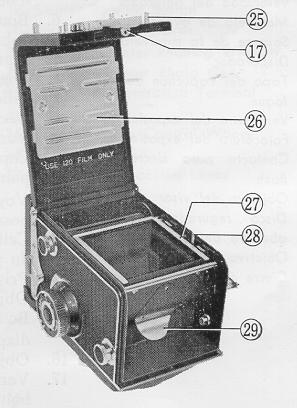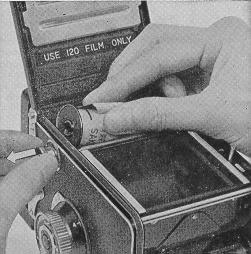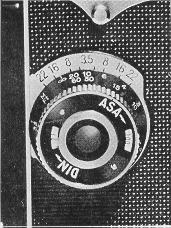and historical purposes, all rights reserved.
This page is copyright© by
This page may not be sold or distributed without
the expressed permission of the producer.
I have no connection with any camera company.
This camera manual library is for reference
and historical
purposes, all rights reserved.
This page is copyright© by
![]() , M.
Butkus, NJ.
, M.
Butkus, NJ.
This page may not be sold or distributed without
the expressed permission of the producer.
I have no connection with any camera company.
On-line camera manual library If you find this manual useful,
how about a donation of
$3 to:
M. Butkus, 29 Lake Ave.,
High Bridge, NJ 08829-1701
and send your e-mail
address
so I can thank you.
Most other places would charge
you $7.50 for
a electronic copy
or $18.00 for a hard to read Xerox copy.
buy new manuals, and pay their shipping costs.
It'll make you feel better, won't it ?
If you use Pay Pal, use the link below.
Use the above address for a check, M.O. or cash.
Back to main camera manual page
Click here to Yashica
Mat EM PDF manual
created from this HTML file
- Better Printing -

DESCRIPTION OF YASHICA MAT-EM
 |
1. Magnifying Glass 2. Sports finder Frame 3. Strap Holder 4. Film Counter Window 5. Lens Opening & Shutter Speed Window 6. Shutter Speed Control Wheel 7. Crank 8. Crank Rest 9. Shutter Release Button 10. Focusing Hood Cover 11. Exposure Meter Reading Window 12. Exposure Meter Photo Cell |
|
13. Flash Synchronization Terminal 14. Viewing Lens 15. Lens Aperture Control Wheel 16. Taking Lens 17. Back Cover Locking Lever 18. Spool Locking Spring 19. Depth-of-Field Scale 20. Exposure Setting Reading Scale 21. Focusing Knob 22. MX Synchro-selector
|
 |
 |
23. Spool Locking Spring 24. Self-timer 25. Tripod Socket 26. Film Pressure Plate 27. Film Setting Mark 28. Film Reverse Arm 29. Film Tension Spring
|
LOADING FILM
|
|
|
(1 ) To unlock the back cover turn the tripod socket in the direction marked
'O.' (2) Remove the Take-up Spool in the Lower Film Chamber by pulling out Lower
Spool Locking Spring.
|
(4) Flip up, the Film Transport Crank and slowly wind it clockwise so that the wider slot of the Take-up Spool in the upper Film Chamber faces upward. Then gently draw out the film leader and thread it firmly and evenly into the slot. (5) Gently wind the Crank clockwise. (6) Advance the film by slowly winding the Crank until the arrow on the film points to the triangles on either side of the camera body. (7) Close the camera back cover and lock it by turning the Tripod-Socket in the direction marked 'C'. The letter 'S' will appear in the Film Counter Window. |
 |
|
|
CRANK OPERATION
 |
(1 ) Wind the crank clockwise until ill comes to a stop. The letter 'S' will
hove disappeared and No. l will appear in the Film Counter Window.
(2) Then wind the crank counter-clockwise until it stops. You are ready to snap your first picture.
|
 |
For subsequent exposures a smooth pendulum swing, first downward to stop and then upward to stop, advances the film and winds the shutter simultaneously. |
 |
(A) The downward wind advances the film and moves up the number of the next film in the Film Counter Window. (B) The upward wind winds the shutter. (C) The position of the crank
when it is flipped back into its rest after your pictures have been taken.
The shutter should not be kept wound when not in use because it weakens the shutter spring and there is the possibility you may unknowingly press the shutter button and waste a film.
|
ASA-DIN CONVERSION SCALE
 |
When using film rated in DIN index, move conversion scale so that DIN number of the film appears in the window. ASA number of the film, at the same time, appears in the window at the opposite side of the scale. Set the ASA number in to the ASA Indicator Window. |
 |
LENS OPENING AND SHUTTER SPEED
(A) The arrow points to the Lens Opening and Shutter Speed Scale
Window. The letter "f" on the left of the window indicates lens opening
and 'sec' indicates shutter speed.
(B) The shutter speed is set by turning the Control Wheel with your right
hand thumb either up or down as indicted by the arrow. The red shutter speed
figures should be set so that the black triangles on the window run exactly
through the center of the figures.
(C) The lens opening is set by turning the Control Wheel with your left-hand thumb either up or down as indicated by the arrow. The black lens opening figures should be set so that black triangles on the window run exactly through the center of the figures.
|
HOW TO USE EXPOSURE READING SYSTEM
 |
 |
(1) Move ASA Setting Knob so that ASA number of the film in use appears in
ASA Indicator Window.
(2) Turn Exposure Indicator Adjusting Knob to match the 'Green Index Arrow' to
the red needle.
(3) Read correct exposure combination indicated in Exposure Indicator Window.
They are the proper exposure combination of lens aperture and shutter speed to
be set on your camera
(4) Turn Shutter Speed Control Wheel and Lens Opening Control Wheel to bring the
pertinent shutter speed and lens opening in to the center of the window located
on the top of viewing lens.
SIGHTING THE SUBJECT AND FOCUSING
|
(1 ) Open the focusing hood by lifting it at the back, and now point your Yashica at the subject, (2) Rotate the Focusing Knob until your subject on the ground glass screen becomes sharp. The bright circle in the center of the ground glass viewing screen enables you to obtain a sharp focus and should be the center of the picture you are composing on the screen. The red lines on the screen help you to judge proportion and compose your picture. Compose your subject on the ground glass as you would like to see it in the final picture. |
 |
MAGNIFYING GLASS
 |
For critical focusing (A) Raise the Magnifying Glass by pressing the front of the Focusing Hood
Cover inward, holding the Focusing Hood so that it does not close. (B) Always make sure that you have first lowered the Magnifying Glass before closing the Focusing Hood. |
SPORTS FINDER
 |
Sight your subject through the Sports Finder Window. (A) Depress the Focusing Hood Cover until il clicks into place. Lift the
Yoshica to your eye level.
(B) Push the Release Button to close the hood cover.
|

TAKING FLASH PICTURES
| FLASH PICTURES
Correct exposures for flash pictures will be obtained easily and correctly by consulting the guide numbers printed on the package of the flash bulbs. When taking color flash pictures you may need filters or have to use proper bulbs according to the type of films (Day-light or Tungsten) you are using. Your camera dealer will be glad to supply the proper flash attachment for your camera. |
 |
As you become more proficient at taking pictures, you will want to acquire accessories that increase the versatility of your Yashica.
One of the first accessories you will want will b? a flash unit.
Synchronization for flash is built-in. A standard PC connector
plugs into the flash terminal.
The battery case is attached to the camera by an arm that screws into the tripod
socket.
| Selector Position | M | X | X |
| Bulb used | M type | F type | Electronic Flash |
| Shutter Speed | Any Speed | 1/60 or slower | Any Speed (When using Self-Timer) |
SELF-TIMER
 |
For taking self-portraits or group
pictures, you have about 8 seconds to get into the picture. Therefore your
camera must be mounted on a tripod or brace to pre. vent o blurred picture.
Caution! Be sure to move the synchro selector to the X position when using Self-timer. |
UNLOADING FILM
| After all 12 pictures have been taken, wind the Film Transport Crank about 6 times to take up the remaining film and open the camera and remove the film. |
 |
CABLE RELEASE
 |
A standard. overlap-type Cable Release can be fitted to your Yashica. Simply unscrew the Shutter Release Ring and Screw in the Cable Release. Your camera dealer will supply the proper cable release for your camera. See left picture. |
THE LENS OPENING
The lens opening controls the amount of light that will pass through
the lens onto the light-sensitive film.
Your Yashica MAT-EM with its
Yashinon lens offers openings f / 3 5, 4,56,8,11,16, and 22.
|
|
| Notice that the lower the number, the
larger the opening F 3 5 is the largest opening, f 22 the smallest
To set the lens opening, move the Aperture Control Wheel to the desired number on the Aperture Scale |
SHUTTER SPEED
The Shutter Speed
controls the duration of the exposure. Shutter speeds on this camera with its
fine Copal Shutter are 1, 1/2, 1/4, 1/8, 1/l5, 1/30, 1/60, 1/125, 1/250, 1/500
of a second and B. The 'B' setting is for taking pictures with an exposure
longer than 1 second. Use a Tripod or Brace when using B. When you press the
Shutter Release
Button on the "B" setting the shutter stays open until you release pressure on
the button.
It is advisable to set the shutter speed before you wind the shutter all times.
DEPTH-OF-FIELD
 |
When you focus the camera on a subject there is a certain distance in front
of and back of the subject within which other objects will also appear sharp.
This is known as the " Depth-of-Field," and it varies with the lens aperture.
The smaller the aperture, the greater the Depth-of-Field.
If the camera is focused at 10 meters and the lens aperture is f / 16, the Depth-of-Field {area in which all objects are sharp! is from about 5 meters to infinity.
|
Notice!
Be sure to replace the lens Cap when your camera is not in use.
Keep your camera away from dust and moisture. For cleaning the lens surface to
remove dust or dirt, always wipe very lightly by using clean gauze or lens
cleaning cloth. Do not wipe the lens with a dirty handkerchief. When you are not
using your camera for a long period do not leave the shutter set.